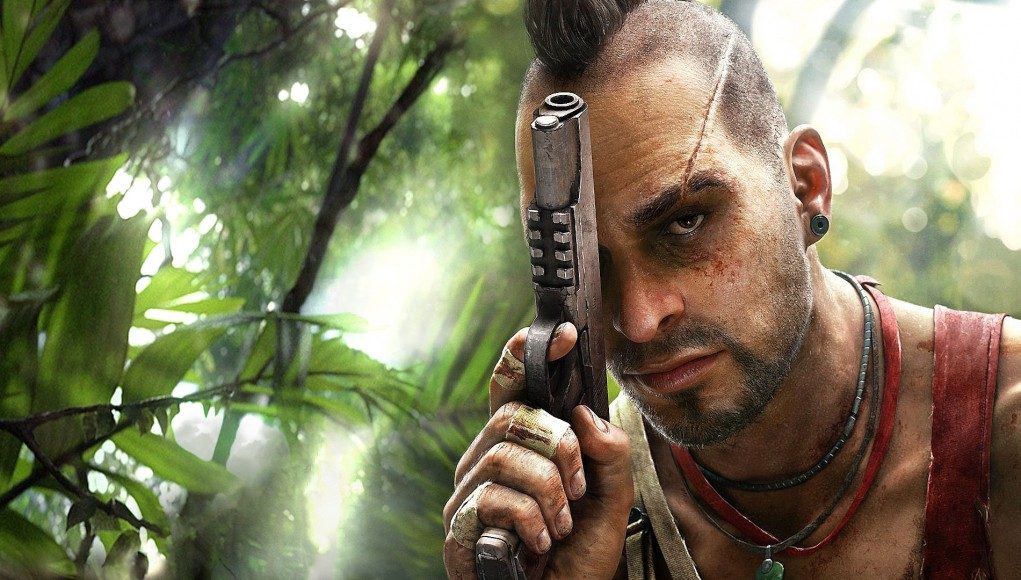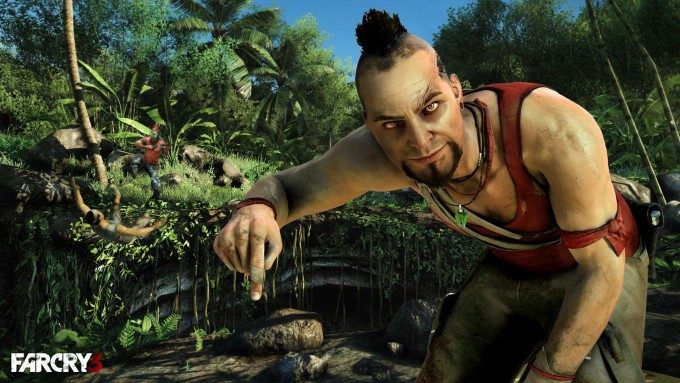Ubisoft’s Montreal office is making some pretty big strides toward prototyping VR games to discover just how far they can push the boundaries of controls and narrative in the virtual space. Olivier Palmieri, game director and head of the Ubisoft Montreal VR team, put me through my paces with the studio’s updated Eagle’s Flight prototype and a narrative experience based on Far Cry 3‘s main villain, Vaas.
I was ushered into Ubisoft’s ‘VR Room’ at Gamescom where I (and three other lucky journalists) would get a chance to play the studio’s updated Eagle’s Flight prototype, a multiplayer aerial combat game played through the eyes of an eagle. With DK2 sitting on my brow and Xbox controller in hand, I was told by Palmieri that I would also get a chance with another prototype currently in the works, one which puts you face to face with the sociopath and chief villain Vaas from Far Cry 3.
Eagle’s Flight
First up was a single player mode to help acquaint me with the basic flight controls. I was told to forget about the gamepad for now and focus on using my gaze, which depends heavily on tilting your head (ear to shoulder) to make the rapid 90 degree turns necessary to shake any offending eagle off my virtual tail.
Quickly mastering the control scheme (forward motion was automatic), I was sent whipping through the streets of late-1700s Paris, an asset lifted from Assassin’s Creed Unity for quick prototyping, and diving through tactically-placed rings that took me under bridges and deftly through the latticed steel girders of the anachronistically placed Eiffel Tower (started in 1887).

Flying like this was easy and comfortable, a fact that Palmieri says was the result of several studies conducted by his team to ensure nausea-free, high speed gameplay. And it’s true, what seemed like 100 mph dive bombs and surprisingly rapid cuts through alleyways and courtyards did null to my stomach, which by that time in the day had already been hastily filled with a dangerous mix of free coffee, free diet coke, and free candy (emphasis on free).
Next up were were divided into 2 two-man teams and told that our new objective was an aerial game of capture the flag. Gamepad controls gave us variable speed and a sound attack that we could use to knock the offending birds from the sky. Starting out on a high ledge (this is Assassin’s Creed we’re talking about here) we were instructed to fly through a yellow beam to grab the flag and race to the opposite side of the map to return it to a purple beam. The result: lots of dead eagles and a silently angry partner due to the fact that I was shooting down the enemy when I should have been grabbing the flag.
See Also: Ubisoft and MM Company to Bring ‘Trackmania’ Full-Motion VR Chair to Paris Games Week
“We’ve made some adjustments and improved it since E3 and [Gamescom],” Palmieri told me after the demo. “For now it’s prototypes focused on gameplay control and comfort, the other on narration—like having a character entering your bubble… I’ve been studying a lot on what causes nausea and what could be the solution. One of the key elements is to make it comfortable even if you have a lot of action like we have, and with this prototype we wanted to prove that we could have a lot of action and still remain comfortable.”
Eagle’s Flight used several solutions that I could recognize, the most obvious of which was that turning controls were 100 percent gaze-based and didn’t rely on the oftentimes gut-wrenching yaw control on traditional gamepads. The eagle’s beak, which obscured the top and bottom portions of my field of view, also certainly gave me a point of reference, like a cockpit might in a VR dogfighter might.
Vaas VR
This was a decidedly much quicker experience, which puts you in a recreation of a Far Cry 3 cutscene to hear Vaas, the mohawked South African slave trader (and all around rude dude), speak at length about how bad he is.
“Did I ever tell you what the definition of insanity is? Insanity is doing the exact… same fucking thing… over and over again expecting… shit to change… That. Is. Crazy. The first time somebody told me that, I dunno, I thought they were bullshitting me, so, I shot him...” Nice.
I was plopped down with my hands tied in front of Vaas and lived out the role to the very end, up to when you’re thrown off the side of a cliff into the water below. This portion of the experience was my least favorite, as the game’s camera is dragged to an unnatural position, forcing your perspective to my ultimate discomfort.
There’s no denying that Ubisoft wants take part in the upcoming wave of consumer-level VR games, and even with early glimpses coming from the studio’s Montreal office showing impressive attention to controls and conceptual repurposing, we still don’t know exactly when, how, or what the studio is cooking up in terms of original IP for virtual reality.
Ubisoft has since released two motion platform VR exhibits; from their Raving Rabidds Theme Park Ride, a virtual roller coaster featuring the moronic rabbits Rayman Raving Rabbids, to a full-motion chair debuting at Paris Games Week where TrackMania 2 fans can strap in a race head to head.
We’re eager to see what they have planned for the rapidly approaching consumer release of the big three major headsets, and whether Eagle’s Flight might make it into a full game.








